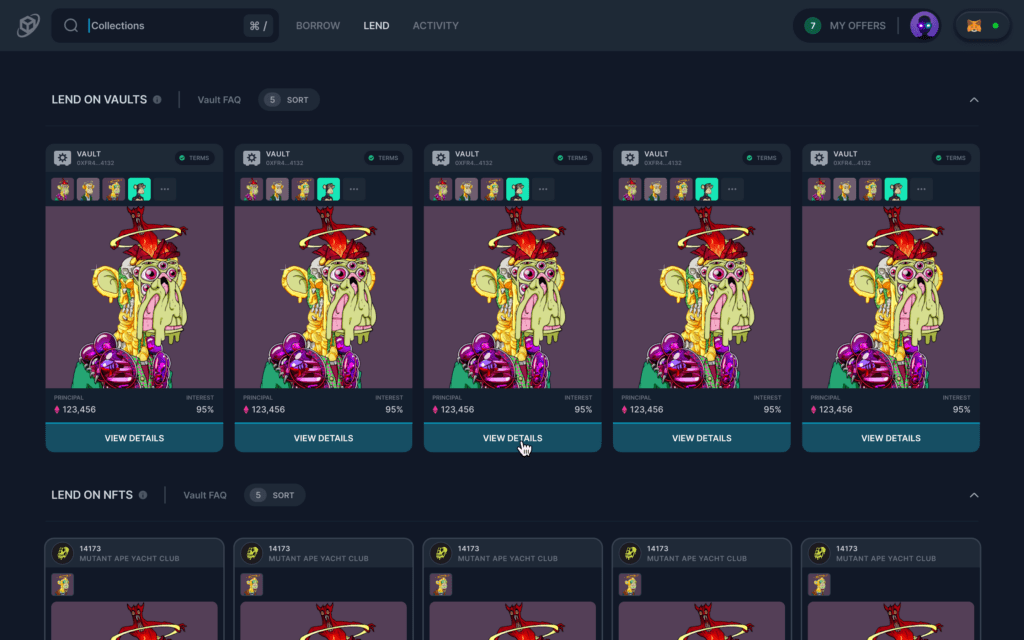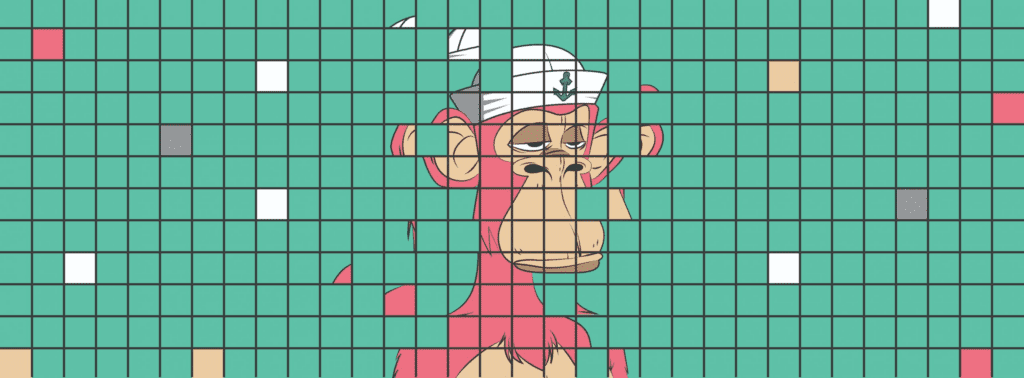Key Points:
- More developers and users are joining NFTFi.
- NFTs are being used by NFTFi to fund transactions by gaining access to more liquid assets.
- The NFTFi protocols were developed to solve the liquidity and value barriers of NFTs, as well as to give an incentive for collectors to buy and hoard NFTs as a long-term asset.
Blur, a newcomer on the NFT scene, has been listed on exchanges and is offering a “huge” airdrop to users. This draws the attention of the community to this project, as well as the NFTFi or NFT Marketplace in general.

Blur surpassed OpenSea as the leading NFT trading platform at the end of last year, and now controls more than 50% of the market. In a bear market, how can it compete with the industry leader OpenSea?
Blur, as opposed to conventional NFT trading platforms, is an aggregation platform for professional NFT traders. It combines trade lists like OpenSea, LooksRare, and X2Y2, and clearly shows information like the floor price, qualities, ranking, cost price, and recent price fluctuations for each NFT royalty charge.
Looking back on the current NFT track, there are still a large number of digital collection speculators who appeared in the previous round of the bull market, and mainstream trading markets such as OpenSea charge exorbitant fees for each transaction, NFT holders frequently face difficulties in selling embarrassing situation.
In the end, the track’s long-term growth has been hampered by NFT’s financial issues. The appearance of Blur this year has resulted in a breakthrough in the NFT liquidity dilemma. We’ll start with its definition and then look at how the NFTFi project may help solve the NFT liquidity problem.
What is NFTFi?
NFTFi is an abbreviation for “NFT” and “Finance,” with the goal of “increasing NFT liquidity and optimizing cash flow” for NFT collectors.
The NFTFi protocols were developed to solve the liquidity and value barriers of NFTs.
The NFTFi ecosystem will also allow NFT collectors to maximize their cash flow, creating further incentives for them to hold NFT as an asset class with long-term potential rather than as a means of speculative investment.
Is NFTFi useful?
Assume you possess an NFT that you want to retain for a long time. If it’s from a popular “blue-chip” collection, you’ve locked up a lot of money in that jpg that you can’t get to.
What if you were in an accident or needed money right now for another opportunity? You may be compelled to sell at a loss, or you could utilize NFTFi to unlock a portion of the entire value without giving up ownership (unless you were to later default on repaying the loan).
This provides an excellent chance for lenders to make a return while providing NFT holders with emergency funds. This presents an interesting opportunity for smart investor to put their NFT collections to work.
The liquidity of game NFT markets varies according to how popular and active the game’s player base is, which has been associated with market conditions in this initial cycle since many owners were speculators rather than committed players. For this reason, NFTFi will reverse once more enjoyable games with long-term token economies are introduced.

To put it simply, NFTFi is the financialization of NFT. But, we must recognize that the process of NFT financialization does not occur overnight. Direct NFT transactions may be carried out on the trading platform in the early stages of NFT development, realizing the commercialization of NFT.
The evolution of transaction techniques such as NFT loans and pledges from direct to indirect transactions has propelled NFT towards a stage of true financialization. Moreover, the securitization of NFT goods will indicate further financialization (Financial Deepening). Nonetheless, the NFT track is still in its second stage of investigation.
How does NFTFi solve liquidity problems?
Marketplace
The marketplace model (or NFT exchange) is the most widely used today, connecting NFT buyers and sellers and providing liquidity to the NFT market.
Yet, because of the bid-ask mechanism, NFT is less liquid than other investment channels. NFTs within the same BST may be priced differently based on rarity or other appealing attributes, leading to price disparities amongst NFTs.
The employment of various valuation methodologies, including emotional pricing, has increased the price difference between bids and offers for the majority of NFTs on the market today.
Borrowing and lending
NFT financing is a developing segment of the NFT business. NFT lending, like DeFi lending, is the act of collateralizing your NFT in return for instant access to a crypto loan, which is often handled on-chain through a smart contract. The smart contract includes the assets, the liquidity (loan), and the loan terms and conditions.
The combination of DeFi with NFTs has provided NFT holders with more easy and interesting options by making their NFTs more “liquid.”
Projects in the lending NFT sector may be grouped into two primary categories: “borrow and buy first, pay later”. The lending sector in NFT operates similarly to DeFi, except the collateral is often blue-chip NFT to assure liquidity.
As the floor price of NFT collections declines, projects may establish suitable liquidation price levels to protect lenders. The JPEG’d project, for example, permits the usage of NFTs to produce stablecoins.
The purchase first, pay later concept requires the customer to pay a certain sum ahead to acquire the NFT and then refund the remainder within a certain time frame.
The procedure of NFT Lending/Borrowing:
- The NFT asset you choose as collateral is sent to an NFTFi escrow smart contract.
- Prospective lenders submit bids; if you accept one, your asset is locked in the smart contract and the lent ETH is sent to your wallet (or another cryptocurrency).
- To reclaim the NFT assets you placed as collateral, you must return the loan plus interest under the agreed-upon conditions.
- If you do not return the loan on time, the lender may foreclose on your home.
It should be noted that if the lender forecloses, the NFT will be transferred to their wallet. The origination fee and loan amount are eliminated since it is a non-recourse loan.
Derivatives
Derivatives NFT is a decentralized asset that is created from financial instruments like options, futures contracts, or other contracts (such as swaps).
This enables people to readily own these assets while also ensuring privacy and safety.
Aggregators
Aggregator is a solution for collecting prices from several NFT exchanges that makes it easier for users to purchase and sell NFTs. There are several prominent NFT Aggregators platforms available today, including OpenSea, Rarible, SuperRare, and Nifty.
NFT Fractionalization
NFT fractionalization, also known as “NFT fragmented,” is a novel approach that allows investors and regular users to easily acquire blue-chip NFT collections at very high floor prices.
NFT fractionalization distributes ownership of an NFT through a collection of fungible tokens linked to the original NFT.
The NFT is put in a vault to be fractionalized. The original NFT is then represented by ERC-20 tokens, each of which represents a portion of ownership in the original NFT.

Valuation Tool
The NFT Valuation Tool is a popular tool in the NFT investing community.
This program utilizes artificial intelligence (AI) technologies to study and estimate the value of an NFT based on characteristics such as rarity, popularity, artist creation, and past transaction history.
The tool is “integrated on several major NFT Marketplace platforms,” including OpenSea, Rarible, and SuperRare, making determining the worth of an NFT easier and quicker.
NFT Renting
Assume you possess an NFT with utility (especially game NFT). You may either utilize that utility yourself or rent NFTs to others for a price.
NFT rental allows you to enjoy the advantages of owning an NFT without the financial commitment of purchasing one.
Over-Collateralized Renting
Potential tenants may acquire access to the NFT they wish to borrow by posting collateral worth more than the NFT price. Borrowers may then use the NFT for the time period defined by the NFT holder and the encoded smart contract to which the NFT is linked.
Under-Collateralized Renting
The main distinction is that the renter gets simply a wrapped version of the original NFT with the same functionality.
Platforms that provide Under-collateralized renting enable lenders to deposit their NFT and wrap it. After renting the NFT and paying the rental cost, the renter gets the wrapped NFT with the same utility as the original. The wrapped NFT is burnt once the contract ends, and the rental amount is transferred to the lender.
Conclusion
NFTFi is a supplementary tool that we feel is required to assist NFT markets in reaching a larger capital base. It has the potential to be crucial in providing NFTs with the components needed for the space to be widely recognized as an asset class.
NFTFi is developing as one of the most intriguing newer Web3 developments. This sector tackles the liquidity challenge that NFTs experience by exposing them to a broad range of new financial use cases that other asset classes now enjoy.
These new financial instruments, whether financial primitives or more complex money legos,’ have the potential to immediately activate innovative value flows for both current and new market participants.
Based on the past studies of the NFTFi track, it is clear that NFTFi will remain one of the focal points in 2023. Expanding NFTFi and generating new possibilities will also provide additional chances and benefits to developers searching for space to join NFT, ensuring that NFT remains one of the most convenient and appealing methods for consumers to access Web3.
DISCLAIMER: The Information on this website is provided as general market commentary and does not constitute investment advice. We encourage you to do your own research before investing.
Join us to keep track of news: https://linktr.ee/coincu
Harold
Coincu News














